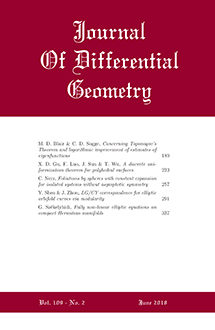Abstract
We prove the Riemannian Penrose Conjecture, an important case of a conjecture [41] made by Roger Penrose in 1973, by defining a new flow of metrics. This flow of metrics stays inside the class of asymptotically flat Riemannian 3-manifolds with nonnegative scalar curvature which contain minimal spheres. In particular, if we consider a Riemannian 3-manifold as a totally geodesic submanifold of a space-time in the context of general relativity, then outermost minimal spheres with total area $A$ correspond to apparent horizons of black holes contributing a mass $\sqrt{A/16\pi}$, scalar curvature corresponds to local energy density at each point, and the rate at which the metric becomes flat at infinity corresponds to total mass (also called the ADM mass). The Riemannian Penrose Conjecture then states that the total mass of an asymptotically flat 3-manifold with nonnegative scalar curvature is greater than or equal to the mass contributed by the black holes.
The flow of metrics we define continuously evolves the original 3-metric to a Schwarzschild 3-metric, which represents a spherically symmetric black hole in vacuum. We define the flow such that the area of the minimal spheres (which flow outward) and hence the mass contributed by the black holes in each of the metrics in the flow is constant, and then use the Positive Mass Theorem to show that the total mass of the metrics is nonincreasing. Then since the total mass equals the mass of the black hole in a Schwarzschild metric, the Riemannian Penrose Conjecture follows.
We also refer the reader to the beautiful work of Huisken and Ilmanen [30], who used inverse mean curvature flows of surfaces to prove that the total mass is at least the mass contributed by the largest black hole.
Citation
Hubert L. Bray. "Proof of the Riemannian Penrose Inequality Using the Positive Mass Theorem." J. Differential Geom. 59 (2) 177 - 267, October, 2001. https://doi.org/10.4310/jdg/1090349428
Information





